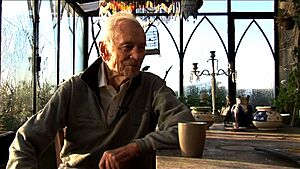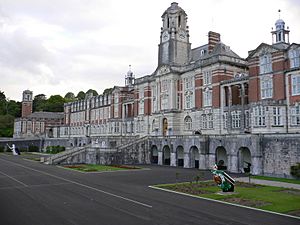Bill King (Royal Navy officer) facts for kids
Quick facts for kids
Bill King
|
|
|---|---|

Bill King
|
|
| Birth name | William Donald Aelian King |
| Nickname(s) | Bill |
| Born | 23 June 1910 |
| Died | 21 September 2012 (aged 102) |
| Allegiance | |
| Service/ |
|
| Years of service | December 1927 – April 1946 |
| Rank | Commander |
| Unit | Submarine Service |
| Commands held | Commanding officer:
|
| Battles/wars | North Sea (1939–40) Mediterranean Sea (1941) Action of 17 July 1944 |
| Awards | Distinguished Service Order (1940) Distinguished Service Cross (1940) Bar to the DSO (1945) Arctic Emblem (2006) Others: 1939–1945 Star, Atlantic Star, Africa Star, Burma Star, War Medal 1939–1945 Civilian: Blue Water Medal (1975) |
| Relations | Anita Leslie (spouse) William King (grandfather) |
| Other work | Farmer Solo circumnavigator (1969–73) Author (1958–97) |
Commander William Donald Aelian King, known as Bill, was a brave British naval officer, a skilled sailor, and an author. He was born on June 23, 1910, and passed away on September 21, 2012.
Bill King was the oldest person to take part in the first ever non-stop, solo yacht race around the world. This famous race was called the Sunday Times Golden Globe Race. He was also the only person to command a British submarine on both the first and last days of World War II.
After the war, Bill King successfully sailed around the world by himself in 1973. This was his third attempt! During this amazing trip, his boat crashed into a large sea creature. Even then, he managed to fix his boat and reach a safe port.
Contents
Bill King's Early Life
William Donald Aelian King was born in 1910. His great-grandfather, William King, was a geology professor. He was famous for being the first to say that Neanderthals were a different type of human from us.
Bill King's father was a soldier who fought in World War I. Sadly, his father died in the war in 1917 when Bill was young. Because of this, Bill was raised by his mother and grandmother. His grandmother was a very adventurous woman. She learned to ski when she was 75 and was still sailing when she was in her eighties!
When Bill King was twelve years old, he went to the Royal Naval College in Dartmouth. This is where he trained to become a naval officer. He was a very good athlete there. He was a boxer and a "champion long-distance runner."
In December 1927, Bill King joined the battleship Resolution. He served on this ship in the Mediterranean Sea. He became a midshipman, which is a junior officer rank.
Later, he served on the submarine Orpheus near China. In 1932, he was promoted to lieutenant. He then trained to become a submarine commander. In May 1939, just before World War II began, he took command of the submarine Snapper.
World War II Hero
During World War II, Bill King commanded three different Royal Navy submarines. These were the Snapper, Trusty, and Telemachus. He sailed these submarines in the North Sea, the Mediterranean Sea, and the Far East.
When the war started, King and Snapper were sent to patrol the North Sea. In December 1939, Snapper was hit by a British aircraft by mistake. Luckily, the submarine was not damaged.
Between December 1939 and July 1940, Snapper sank six enemy ships. These included a tanker, a merchant ship, and several minesweepers and armed trawlers. Sadly, the Snapper was later lost with all hands under a different commander.
In 1941, King served on the submarine Trusty in the Mediterranean Sea. Later, from 1943 to 1945, he commanded the submarine Telemachus.
One of his most famous actions was sinking the Japanese submarine I-166 on July 17, 1944. This happened in the Strait of Malacca. Telemachus tracked the Japanese submarine for 30 minutes. Then, King fired six torpedoes. One hit the I-166, sinking it.
During the war, Bill King was promoted to Commander. He received seven medals for his bravery. These included the Distinguished Service Order (DSO) and the Distinguished Service Cross (DSC). He earned these for his "daring, endurance and resource" in submarine operations. He received another medal, a bar to his DSO, for sinking the I-166. In 2006, he received an eighth medal, the Arctic Emblem.
Bill King retired from the Royal Navy in 1948.
Life After the War
In 1949, Bill King married Anita Leslie. She was a writer who had also served bravely in the war. She was an ambulance driver in the French Army and received a special medal called the Croix de Guerre. Anita wrote many books, including a biography of Francis Chichester, another famous solo sailor. Bill and Anita had two children, Richard and Leonie.
After the war, Bill King became a farmer. He and his wife bought Oranmore Castle, a very old 15th-century castle in Ireland. They worked to create an organic farm and garden there.
Sailing Around the World Alone
By 1967, Bill King decided he wanted to sail around the world by himself. He had a special boat built for this journey. It was called the Galway Blazer II. This boat was a two-masted schooner with a unique "junk rig" sail design, inspired by boats King had seen in China.
In 1968, a big solo sailing race was announced: the Sunday Times Golden Globe Race. At 58 years old, Bill King became the oldest person to enter this first-ever solo round-the-world yacht race. He said he joined the race to help himself recover from his many years serving in submarines, which had left him feeling very stressed.
King started the race on August 24, 1968. He ate only raw food, like dried fruit and sprouts he grew on board. He spent his time reading religious texts and classic novels. He said he never felt sad because of the beauty of the ocean around him.
During the race, his boat capsized in huge waves, breaking both masts. King had to be rescued and towed to South Africa.
He tried again in 1969, but had to stop. In 1970, he made another attempt. This time, a large sea creature (possibly a whale or shark) damaged his boat about 400 miles southwest of Australia. The hull of his boat was badly broken. Bill King showed incredible skill and bravery. He quickly fixed the hole from both the outside and inside of the boat. After three days of hard work, he managed to sail his damaged boat back to port.
Finally, in 1973, Bill King successfully completed his solo journey around the world! In 1975, he received the Blue Water Medal for his amazing achievement.
Later Years and Legacy
Bill King continued to live at Oranmore Castle with his daughter Leonie. His life story has inspired many films, music, and art.
He was featured in documentaries about the Golden Globe Race and his wartime experiences. One touching story is about his meeting with Akira Tsurukame, whose father died on the Japanese submarine I-166 that King sank. They, along with Katja Boonstra, whose father died on a Dutch submarine sunk by I-166, planted a tree together at Oranmore Castle. This act of "reconciliation" showed how people can come together even after war.
In 2009, Bill King's great-nephew made a short film called King of the Waves. It told the story of King's solo sailing adventure and included interviews with Bill King himself.
Bill King passed away in September 2012. He was the oldest surviving World War II submarine commander at the time of his death.
Books by Bill King
- 1958: The Stick and the Stars. (About his wartime experiences)
- 1969: Capsize. (About his sailing adventures)
- 1975: Adventure in Depth.
- 1983: Dive and Attack. (An updated version of The Stick and the Stars)
- 1989: The Wheeling Stars : A Guide for Lone Sailors.
- 1997: Kamikaze: the Wind of God
See also
- Castle Leslie
- Shane Leslie
- Anita Leslie King
- Oranmore Castle




